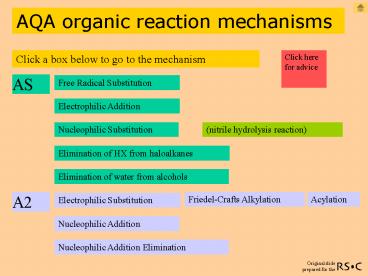AQA organic reaction mechanisms - PowerPoint PPT Presentation
1 / 37
Title:
AQA organic reaction mechanisms
Description:
Click a box below to go to the mechanism Click here for advice AS Free Radical Substitution Electrophilic Addition Nucleophilic Substitution (nitrile hydrolysis reaction) – PowerPoint PPT presentation
Number of Views:425
Avg rating:5.0/5.0
Title: AQA organic reaction mechanisms
1
AQA organic reaction mechanisms
Click a box below to go to the mechanism
Click here for advice
AS
Free Radical Substitution
Electrophilic Addition
Nucleophilic Substitution
(nitrile hydrolysis reaction)
Elimination of HX from haloalkanes
Elimination of water from alcohols
Friedel-Crafts Alkylation
Acylation
A2
Electrophilic Substitution
Nucleophilic Addition
Nucleophilic Addition Elimination
2
Free radical substitution
chlorination of methane
i.e. homolytic breaking of covalent bonds
Overall reaction equation
CH4 Cl2
CH3Cl HCl
Conditions
ultra violet light
excess methane
to reduce further substitution
3
Free radical substitution mechanism
ultra-violet
Cl2
initiation step
two propagation steps
termination step
CH3Cl
minor termination step
CH3CH3
4
Further free radical substitutions
Overall reaction equations
CH3Cl Cl2
CH2Cl2 HCl
CH2Cl2 Cl2
CHCl3 HCl
CHCl3 Cl2
CCl4 HCl
Conditions
ultra-violet light
excess chlorine
5
Electrophilic addition
bromine with propene
mechanism
CH3CHCH2
Br2
CH3CHBrCH2Br
1,2-dibromopropane
hydrogen bromide with but-2-ene
mechanism
CH3CHCHCH3
HBr
CH3CH2CHBrCH3
2-bromobutane
concentrated sulphuric acid with but-2-ene
mech
CH3CHCHCH3
HOSO3H
CH3CH2CH(OSO3H)CH3
2-butylhydrogensulphate
6
bromine with propene
Electrophilic addition mechanism
reaction equation
carbocation
1,2-dibromopropane
7
hydrogen bromide with trans but-2-ene
Electrophilic addition mechanism
reaction equation
carbocation
2-bromobutane
8
concentrated H2SO4 with cis but-2-ene
Electrophilic addition mechanism
reaction equation
carbocation
2-butylhydrogensulphate
9
Nucleophilic substitution
hydroxide ion with bromoethane
mechanism
CH3CH2Br
OH-
CH3CH2OH Br-
(aqueous)
ethanol
cyanide ion with iodoethane
mechanism
CH3CH2I (ethanol)
CN-(aq)
CH3CH2CN I-
propanenitrile
ammonia with bromoethane
mechanism
CH3CH2Br
NH3
CH3CH2NH2
2
NH4Br-
aminoethane
10
hydroxide ion with bromoethane
Nucleophilic substitution mechanism
ethanol
reaction equation
11
cyanide ion with iodoethane
Nucleophilic substitution mechanism
propanenitrile
reaction equation
12
ammonia with bromoethane
Nucleophilic substitution mechanism
aminoethane
reaction equation
13
Nitrile hydrolysis
Acid hydrolysis of nitriles
CH3CH2CN
H2O H
CH3CH2COOH
NH4
2
propanoic acid
Reflux with strong acid
eg HCl (aq)
14
Elimination of HX from haloalkanes
Elimination of HBr from 2-bromopropane
OH-
CH3CHCH2 H2O Br-
CH3CHBrCH3
(in ethanol)
propene
acting as a base
15
Haloalkanes and hydroxide ions
alcohol
nucleophilic substitution
RCH3CH2OH Br-
(aqueous)
OH-
hydroxide acts as a nucleophile
RCH2CH2X
hydroxide acts as a base
(ethanol)
OH-
elimination
RCHCH2 H2O X-
alkene
16
Elimination of water from alcohols
Elimination of H2O from propan-1-ol
CH3CH2CH2OH
CH3CHCH2 H2O
Heat with concentrated H2SO4
17
Elimination mechanism water from propan-1-ol
protonated alcohol
propene
carbocation
reaction equation
18
Electrophilic Substitution
Nitration of benzene
C6H6
HNO3
C6H5NO2
H2O
Conditions / Reagents
concentrated HNO3
and concentrated H2SO4
50oC
mechanism
19
electrophilic substitution mechanism (nitration)
the nitronium ion
HNO3
2H2SO4
H3O
2HSO4-
2. Electrophilic attack on benzene
3. Forming the product
and re-forming the catalyst
reaction equation
20
Friedel-Crafts alkylation
Where an H atom attached to an aromatic ring is
replaced by a C atom
Alkylation of benzene
electrophilic substitution
C6H6
RCl
C6H5R
HCl
R alkyl group
Conditions / Reagents
RCl (haloakane)
and anhydrous AlCl3
0 - 25oC
to prevent further substitution
21
Alkylation example
With chloroethane
overall reaction equation
C6H6 CH3CH2Cl
C6H5CH2CH3
HCl
Three steps in electrophilic substitution
mechanism
1. Formation of the electrophile (a carbocation)
AlCl3
22
Alkylation electrophilic substitution mechanism 2
2. Electrophilic attack on benzene
3. Forming the product
and re-forming the catalyst
AlCl3
ethylbenzene
23
Friedel-Crafts acylation
An H atom attached to an aromatic ring is
replaced by a C atom where C is part of CO
Acylation of benzene
electrophilic substitution
C6H6
RCOCl
C6H5COR
HCl
Conditions / Reagents
RCOCl (acyl chloride)
and anhydrous AlCl3
50 oC
24
Acylation example
With ethanoyl chloride
overall reaction equation
C6H6 CH3COCl
C6H5COCH3
HCl
Three steps in electrophilic substitution
mechanism
1. Formation of the electrophile (an acylium
ion)
AlCl3
25
Acylation electrophilic substitution mechanism 2
2. Electrophilic attack on benzene
3. Forming the product
and re-forming the catalyst
AlCl3
phenylethanone
26
Nucleophilic Addition
Reduction of carbonyls
primary alcohol
RCH2OH
2H
RCHO
secondary alcohol
2H
RCOR
RCH(OH)R
Conditions / Reagents
NaBH4
and H2SO4(aq)
Room temperature and pressure
27
Nucleophilic Addition Mechanism
alcohol
reduction of propanone
NaBH4 is a source of hydride ions
H
from H2SO4 (aq)
H
propan-2-ol
28
Nucleophilic Addition
addition of hydrogen cyanide to carbonyls to
form hydroxynitriles
HCN
RCOR
RC(OH)(CN)R
RCH(OH)CN
HCN
RCHO
Conditions / Reagents
NaCN (aq)
and H2SO4(aq)
supplies H
supplies the CN- nucleophile
Room temperature and pressure
29
Nucleophilic Addition Mechanism
hydrogen cyanide with propanone
HCN
CH3COCH3
CH3C(OH)(CN)CH3
NaCN (aq) is a source of cyanide ions
H
from H2SO4 (aq)
H
2-hydroxy-2-methylpropanenitrile
30
Nucleophilic Addition Elimination
Acylation of water to give carboxylic acids
RCOOH
HCl
H2O
RCOCl
carboxylic acid
OH
Conditions
room temperature and pressure
31
Formation of ethanoic acid
ethanoyl chloride
H2O
CH3COCl
CH3COOH
HCl
ethanoic acid
OH
mechanism
32
Nucleophilic Addition Elimination Mechanism
nucleophilic addition
elimination
reaction equation
33
Acylation of primary amines to N-alkyl amides
2 RNH2
RCONHR
RNH3Cl-
RCOCl
N-alkylamide
NHR
Conditions
room temperature and pressure
N-propylethanamide
NHCH2CH2CH3
34
Formation of N-propyl ethanamide
from
1-aminopropane
ethanoyl chloride
CH3CH2CH2NH2
2
CH3COCl
CH3CONHCH2CH2CH3
CH3CH2CH2NH3Cl-
N-propylethanamide
mechanism
35
Nucleophilic Addition Elimination Mechanism
nucleophilic addition
elimination
reaction equation
36
Advice
37
References
Steve Lewis for the Royal Society of Chemistry





























